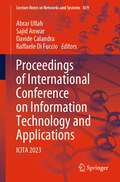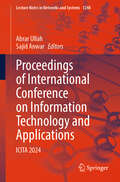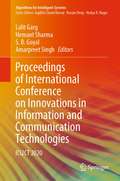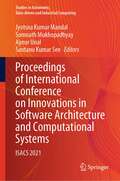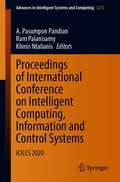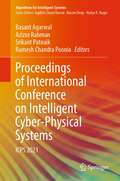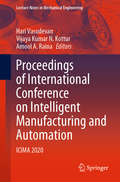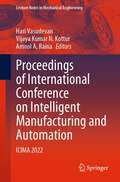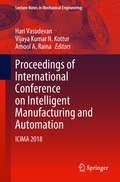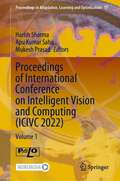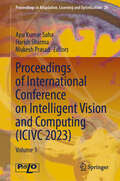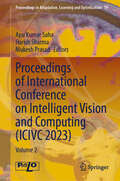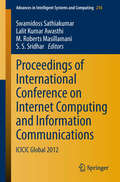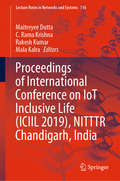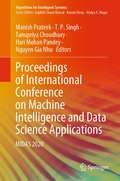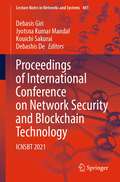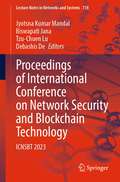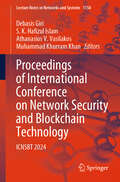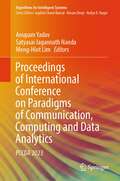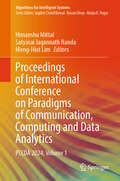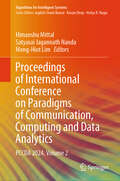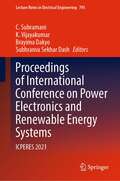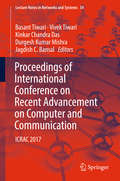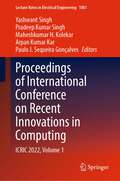- Table View
- List View
Proceedings of International Conference on Information Technology and Applications: ICITA 2023 (Lecture Notes in Networks and Systems #839)
by Sajid Anwar Abrar Ullah Raffaele Di Fuccio Davide CalandraThis book includes high-quality papers presented at 17th International Conference on Information Technology and Applications (ICITA 2023), held in Turin, Italy during 20 – –22 October 2023. The book presents original research work of academics and industry professionals to exchange their knowledge of the state-of-the-art research and development in information technology and applications. The topics covered in the book are cloud computing, business process engineering, machine learning, evolutionary computing, big data analytics, internet of things and cyber-physical systems, information and knowledge management, computer vision and image processing, computer graphics and games programming, mobile computing, ontology engineering, software and systems modelling, human computer interaction, online learning /e-learning, computer networks, and web engineering.
Proceedings of International Conference on Information Technology and Applications: ICITA 2024 (Lecture Notes in Networks and Systems #1248)
by Sajid Anwar Abrar UllahThis book includes high-quality papers presented at 18th International Conference on Information Technology and Applications (ICITA 2024), held in Sydney, Australia, during October 17–19, 2024. The book presents original research work of academics and industry professionals to exchange their knowledge of the state-of-the-art research and development in information technology and applications. The topics covered in the book are cloud computing, business process engineering, machine learning, evolutionary computing, big data analytics, internet of things and cyber-physical systems, information and knowledge management, computer vision and image processing, computer graphics and games programming, mobile computing, ontology engineering, software and systems modeling, human computer interaction, online learning /e-learning, computer networks, and web engineering.
Proceedings of International Conference on Information and Communication Technology for Development: ICICTD 2022 (Studies in Autonomic, Data-driven and Industrial Computing)
by Mohammad Shorif Uddin Mohiuddin Ahmad Yeong Min JangThis book gathers outstanding research papers presented at the International Conference on Information and Communication Technology for Development (ICICTD 2022), held on July 29–30, 2022, at the Institute of Information and Communication Technology (IICT), Khulna University of Engineering & Technology (KUET), Khulna, Bangladesh. The topics covered are ICT in health care, ICT in e-commerce, e-governance, collective intelligence, soft computing, optimization, cloud computing, machine learning, intelligent software, robotics, data science, data security, big data analytics and IoT, information systems, computer network, algorithms, and natural language processing.
Proceedings of International Conference on Innovations in Information and Communication Technologies: ICI2CT 2020 (Algorithms for Intelligent Systems)
by Lalit Garg Hemant Sharma S. B. Goyal Amarpreet SinghThis book gathers selected papers presented at the International Conference on Innovations in Information and Communication Technologies (ICI2CT 2020), held at National University of Singapore, Singapore, during 18–19 December 2020. It presents the works on the intersection of the Computer Science and Communication Engineering. Topics covered in the book include communications engineering, Internet and web technology, computer and information science, artificial intelligence, data science and management, and ICT applications.
Proceedings of International Conference on Innovations in Software Architecture and Computational Systems: ISACS 2021 (Studies in Autonomic, Data-driven and Industrial Computing)
by Jyotsna Kumar Mandal Aynur Unal Somnath Mukhopadhyay Santanu Kumar SenThis book gathers a collection of high-quality peer-reviewed research papers presented at First International Conference on Innovations in Software Architecture and Computational Systems (ISACS 2021), held at Guru Nanak Institute of Technology, Kolkata, India, during 2 – 3 April 2021. The book primarily focuses on developing artificial intelligence-based algorithms and methodologies for enabling intelligent hardware and software systems. This book brings together the latest findings on efficient technological solutions for developing intelligent and hybrid systems, intelligent software architecture, machine intelligence-based analytical tools and also smart sensors and networks. The prime focus is on solving technological problems using state-of-the-art research finding like fuzzy computing, evolutionary and hybrid frameworks, neuro-computing, etc., along with other AI-based computation platforms. The book offers a valuable resource for all undergraduate, postgraduate students and researchers interested in exploring solution frameworks for social good problems using artificial intelligence.
Proceedings of International Conference on Intelligent Computing, Information and Control Systems: ICICCS 2020 (Advances in Intelligent Systems and Computing #1272)
by Klimis Ntalianis A. Pasumpon Pandian Ram PalanisamyThis book is a collection of papers presented at the International Conference on Intelligent Computing, Information and Control Systems (ICICCS 2020). It encompasses various research works that help to develop and advance the next-generation intelligent computing and control systems. The book integrates the computational intelligence and intelligent control systems to provide a powerful methodology for a wide range of data analytics issues in industries and societal applications. The book also presents the new algorithms and methodologies for promoting advances in common intelligent computing and control methodologies including evolutionary computation, artificial life, virtual infrastructures, fuzzy logic, artificial immune systems, neural networks and various neuro-hybrid methodologies. This book is pragmatic for researchers, academicians and students dealing with mathematically intransigent problems.
Proceedings of International Conference on Intelligent Cyber-Physical Systems: ICPS 2021 (Algorithms for Intelligent Systems)
by Basant Agarwal Azizur Rahman Ramesh Chandra Poonia Srikant PatnaikThis book presents innovative work by leading academics, researchers, and experts from industry which is useful for young researchers and students. This book includes selected papers from International Conference on Intelligent Cyber-Physical Systems (ICPS 2021), held at Indian Institute of Information Technology Kota (IIIT Kota), MNIT Jaipur Campus, Jaipur, India, during 16-18 April 2021. The book is a collection of the state-of-the art research work in the cutting-edge technologies related to the artificial intelligence and cyber physical systems.
Proceedings of International Conference on Intelligent Manufacturing and Automation: ICIMA 2020 (Lecture Notes in Mechanical Engineering)
by Hari Vasudevan Vijaya Kumar N. Kottur Amool A. RainaThis book gathers selected papers presented at the Second International Conference on Intelligent Manufacturing and Automation (ICIMA 2020), which was jointly organized by the Departments of Mechanical Engineering and Production Engineering at Dwarkadas J. Sanghvi College of Engineering (DJSCE), Mumbai, and by the Indian Society of Manufacturing Engineers (ISME). Covering a range of topics in intelligent manufacturing, automation, advanced materials and design, it focuses on the latest advances in e.g. CAD/CAM/CAE/CIM/FMS in manufacturing, artificial intelligence in manufacturing, IoT in manufacturing, product design & development, DFM/DFA/FMEA, MEMS & nanotechnology, rapid prototyping, computational techniques, nano- & micro-machining, sustainable manufacturing, industrial engineering, manufacturing process management, modelling & optimization techniques, CRM, MRP & ERP, green, lean & agile manufacturing, logistics & supply chain management, quality assurance & environmental protection, advanced material processing & characterization of composite & smart materials. The book is intended as a reference guide for future researchers, and as a valuable resource for students in graduate and doctoral programmes.
Proceedings of International Conference on Intelligent Manufacturing and Automation: ICIMA 2022 (Lecture Notes in Mechanical Engineering)
by Hari Vasudevan Vijaya Kumar N. Kottur Amool A. RainaThe book comprises of selected papers presented at the Third International Conference on Intelligent Manufacturing and Automation (ICIMA 2022), which was organized by the Departments of Mechanical Engineering and Production Engineering of Dwarkadas J. Sanghvi College of Engineering (DJSCE), Mumbai, jointly with Indian Society of Manufacturing Engineers (ISME). The book focuses on specific topics of Intelligent Manufacturing, Automation, Advanced Materials and Design. It includes original research articles, focusing on the latest advances in the fields of Automation, Mechatronics & Robotics, CAD/CAM/CAE/CIM/FMS in Manufacturing, Artificial Intelligence in Manufacturing, IOT in Manufacturing, Product Design & Development, DFM/DFA/FMEA, MEMS & Nano Technology, Rapid Prototyping, Computational Techniques, Nano & Micro-machining, Sustainable Manufacturing, Industrial Engineering, Manufacturing Process Management, Modelling & Optimization Techniques, CRM, MRP & ERP, Green, Lean & Agile Manufacturing, Logistics & Supply Chain Management, Quality Assurance & Environment protection, Advanced Material Processing & Characterization and Composite & Smart Materials. It is hoped that the contents in the book will serve as reference for future researchers. The book is also expected to act as a valuable resource for the students of Post Graduate and Doctoral Programmes.
Proceedings of International Conference on Intelligent Manufacturing and Automation: Icima 2018 (Lecture Notes In Mechanical Engineering)
by Hari Vasudevan Amool A. Raina Vijaya Kumar KotturThis book presents the outcomes of the International Conference on Intelligent Manufacturing and Automation (ICIMA 2018) organized by the Departments of Mechanical Engineering and Production Engineering at Dwarkadas J. Sanghvi College of Engineering, Mumbai, and the Indian Society of Manufacturing Engineers. It includes original research and the latest advances in the field, focusing on automation, mechatronics and robotics; CAD/CAM/CAE/CIM/FMS in manufacturing; product design and development; DFM/DFA/FMEA; MEMS and Nanotechnology; rapid prototyping; computational techniques; industrial engineering; manufacturing process management; modelling and optimization techniques; CRM, MRP and ERP; green, lean, agile and sustainable manufacturing; logistics and supply chain management; quality assurance and environment protection; advanced material processing and characterization; and composite and smart materials.
Proceedings of International Conference on Intelligent Vision and Computing: Volume 1 (Proceedings in Adaptation, Learning and Optimization #17)
by Harish Sharma Mukesh Prasad Apu Kumar SahaThe conference proceedings book is a collection of high-quality research articles in the field of intelligent vision and computing. It also serves as a forum for researchers and practitioners from both academia and industry to meet and share their expertise and experience. It provides opportunities for academicians and scientists along with professionals, policymakers, and practitioners from various fields in a global realm to present their research contributions and views, on one forum and interact with members inside and outside their own particular disciplines.
Proceedings of International Conference on Intelligent Vision and Computing: Volume 1 (Proceedings in Adaptation, Learning and Optimization #20)
by Harish Sharma Mukesh Prasad Apu Kumar SahaThis book contains outstanding research papers as the proceedings of the 3rd International Conference on Intelligent Vision and Computing (ICIVC 2023). ICIVC 2023 has been organized by National Institute of Technology Agartala, India under the technical sponsorship of the Soft Computing Research Society, India. It was held on November 25-26, 2023 at National Institute of Technology Agartala, India. The conference was conceived as a platform for disseminating and exchanging ideas, concepts, and results of the researchers from academia and industry to develop a comprehensive understanding of the challenges of the advancements of intelligence in computational viewpoints. This book will help in strengthening congenial networking between academia and industry. The conference focused on collective intelligence, soft computing, optimization, cloud computing, machine learning, intelligent software, robotics, data science, data security, big data analytics, signal and natural language processing.
Proceedings of International Conference on Intelligent Vision and Computing: Volume 2 (Proceedings in Adaptation, Learning and Optimization #19)
by Harish Sharma Mukesh Prasad Apu Kumar SahaThis book contains outstanding research papers as the proceedings of the 3rd International Conference on Intelligent Vision and Computing (ICIVC 2023). ICIVC 2023 has been organized by National Institute of Technology Agartala, India under the technical sponsorship of the Soft Computing Research Society, India. It was held on November 25-26, 2023 at National Institute of Technology Agartala, India. The conference was conceived as a platform for disseminating and exchanging ideas, concepts, and results of the researchers from academia and industry to develop a comprehensive understanding of the challenges of the advancements of intelligence in computational viewpoints. This book will help in strengthening congenial networking between academia and industry. The conference focused on collective intelligence, soft computing, optimization, cloud computing, machine learning, intelligent software, robotics, data science, data security, big data analytics, signal and natural language processing.
Proceedings of International Conference on Internet Computing and Information Communications
by Swamidoss Sathiakumar Lalit Kumar Awasthi M. Roberts Masillamani S. S. SridharThe book presents high quality research papers presented by experts in the International Conference on Internet Computing and Information Communications 2012, organized by ICICIC Global organizing committee (on behalf of The CARD Atlanta, Georgia, CREATE Conferences Inc). The objective of this book is to present the latest work done in the field of Internet computing by researchers and industrial professionals across the globe. A step to reduce the research divide between developed and under developed countries.
Proceedings of International Conference on IoT Inclusive Life (Lecture Notes in Networks and Systems #116)
by Rakesh Kumar C. Rama Krishna Maitreyee Dutta Mala KalraThis book gathers selected research papers presented at the AICTE-sponsored International Conference on IoT Inclusive Life (ICIIL 2019), which was organized by the Department of Computer Science and Engineering, National Institute of Technical Teachers Training and Research, Chandigarh, India, on December 19–20, 2019. In contributions by active researchers, the book presents innovative findings and important developments in IoT-related studies, making it a valuable resource for researchers, engineers, and industrial professionals around the globe.
Proceedings of International Conference on Machine Intelligence and Data Science Applications: MIDAS 2020 (Algorithms for Intelligent Systems)
by T. P. Singh Nguyen Gia Nhu Manish Prateek Tanupriya Choudhury Hari Mohan PandeyThis book is a compilation of peer-reviewed papers presented at the International Conference on Machine Intelligence and Data Science Applications, organized by the School of Computer Science, University of Petroleum & Energy Studies, Dehradun, on September 4 and 5, 2020. The book starts by addressing the algorithmic aspect of machine intelligence which includes the framework and optimization of various states of algorithms. Variety of papers related to wide applications in various fields like image processing, natural language processing, computer vision, sentiment analysis, and speech and gesture analysis have been included with upfront details. The book concludes with interdisciplinary applications like legal, health care, smart society, cyber physical system and smart agriculture. The book is a good reference for computer science engineers, lecturers/researchers in machine intelligence discipline and engineering graduates.
Proceedings of International Conference on Network Security and Blockchain Technology: ICNSBT 2021 (Lecture Notes in Networks and Systems #481)
by Debashis De Debasis Giri Jyotsna Kumar Mandal Kouichi SakuraiThe book is a collection of best selected research papers presented at International Conference on Network Security and Blockchain Technology (ICNSBT 2021), organized by Computer Society of India—Kolkata Chapter, India, during December 2–4, 2021. The book discusses recent developments and contemporary research in cryptography, network security, cyber security, and blockchain technology. Authors are eminent academicians, scientists, researchers, and scholars in their respective fields from across the world.
Proceedings of International Conference on Network Security and Blockchain Technology: ICNSBT 2023 (Lecture Notes in Networks and Systems #738)
by Debashis De Jyotsna Kumar Mandal Biswapati Jana Tzu-Chuen LuThe book is a collection of best selected research papers presented at International Conference on Network Security and Blockchain Technology (ICNSBT 2023), held at Vidyasagar University, Midnapore, India, during March 24–26, 2023. The book discusses recent developments and contemporary research in cryptography, network security, cybersecurity, and blockchain technology. Authors are eminent academicians, scientists, researchers, and scholars in their respective fields from across the world.
Proceedings of International Conference on Network Security and Blockchain Technology: ICNSBT 2024 (Lecture Notes in Networks and Systems #1158)
by Athanasios V. Vasilakos Debasis Giri Muhammad Khurram Khan S. K. Hafizul IslamThis book is a collection of best-selected research papers presented at International Conference on Network Security and Blockchain Technology (ICNSBT 2024), held at Jalpaiguri Government Engineering College (JGEC), Jalpaiguri, West Bengal, India, during March 6–8, 2024. The book discusses recent developments and contemporary research in cryptography, network security, cybersecurity, and blockchain technology. Authors are eminent academicians, scientists, researchers, and scholars in their respective fields from across the world.
Proceedings of International Conference on Paradigms of Communication, Computing and Data Analytics: PCCDA 2023 (Algorithms for Intelligent Systems)
by Anupam Yadav Meng-Hiot Lim Satyasai Jagannath NandaThis book is a collection of selected high-quality research papers presented at International Conference on Paradigms of Communication, Computing and Data Analytics (PCCDA 2023), held at South Asian University, New Delhi, India, during 22–23 April 2023. It discusses cutting-edge research in the areas of advanced computing, communications and data science techniques. The book is a collection of latest research articles in computation algorithm, communication and data sciences, intertwined with each other for efficiency.
Proceedings of International Conference on Paradigms of Communication, Computing and Data Analytics: PCCDA 2024, Volume 1 (Algorithms for Intelligent Systems)
by Meng-Hiot Lim Satyasai Jagannath Nanda Himanshu MittalThis book is a collection of selected high-quality research papers presented at the International Conference on Paradigms of Communication, Computing and Data Analytics (PCCDA 2024), held at Pt. Lalit Mohan Sharma Campus, Rishikesh, Sri Dev Suman Uttarakhand University, Uttarakhand, India, during 20–21 April 2024. It discusses cutting-edge research in the areas of advanced computing, communications and data science techniques. The book is a collection of the latest research articles in computation algorithm, communication and data sciences, intertwined with each other for efficiency.
Proceedings of International Conference on Paradigms of Communication, Computing and Data Analytics: PCCDA 2024, Volume 2 (Algorithms for Intelligent Systems)
by Meng-Hiot Lim Satyasai Jagannath Nanda Himanshu MittalThis book is a collection of selected high-quality research papers presented at the International Conference on Paradigms of Communication, Computing and Data Analytics (PCCDA 2024), held at Pt. Lalit Mohan Sharma Campus, Rishikesh, Sri Dev Suman Uttarakhand University, Uttarakhand, India, during 20–21 April 2024. It discusses cutting-edge research in the areas of advanced computing, communications and data science techniques. The book is a collection of the latest research articles in computation algorithm, communication and data sciences, intertwined with each other for efficiency.
Proceedings of International Conference on Power Electronics and Renewable Energy Systems: ICPERES 2021 (Lecture Notes in Electrical Engineering #795)
by Subhransu Sekhar Dash K. Vijayakumar C. Subramani Brayima DakyoThis book features selected papers from the International Conference on Power Electronics and Renewable Energy Systems (ICPERES 2021), organized by SRM Institute of Science and Technology, Chennai, India, during April 2021. It covers recent advances in the field of soft computing applications in power systems, power system modeling and control, power system stability, power quality issues and solutions, smart grid, green and renewable energy technology optimization techniques in electrical systems, power electronics controllers for power systems, power converters and modeling, high voltage engineering, networking grid and cloud computing, computer architecture and embedded systems, fuzzy logic control, fuzzy decision support systems, and control systems. The book presents innovative work by leading academics, researchers, and experts from industry.
Proceedings of International Conference on Recent Advancement on Computer and Communication: Icrac 2017 (Lecture Notes In Networks And Systems #34)
by Durgesh Kumar Mishra Basant Tiwari Vivek Tiwari Kinkar Chandra Das Jagdish C. BansalThe book is a compilation of best papers presented at International Conference on Recent Advancement in Computer and Communication (ICRAC 2017) organized by IMPLab Research and Innovation Foundation, Bhopal, India. The book covers all aspects of computers and communication techniques including pervasive computing, distributed computing, cloud computing, sensor and adhoc network, image, text and speech processing, pattern recognition and pattern analysis, digital signal processing, digital electronics, telecommunication technologies, robotics, VLSI technologies, embedded system, satellite communication, digital signal processing, and digital communication. The papers included are original research works of experts from industry, government centers and academic institutions; experienced in engineering, design and research.
Proceedings of International Conference on Recent Innovations in Computing: ICRIC 2022, Volume 1 (Lecture Notes in Electrical Engineering #1001)
by Arpan Kumar Kar Pradeep Kumar Singh Maheshkumar H. Kolekar Yashwant Singh Paulo J. Sequeira GonçalvesThis book features selected papers presented at the 5th International Conference on Recent Innovations in Computing (ICRIC 2022), held on May 13–14, 2022, at the Central University of Jammu, India, and organized by the university’s Department of Computer Science and Information Technology. The conference was hosted in association with ELTE, Hungary; Knowledge University, Erbil; Cyber Security Research Lab and many other national & international partners. The book is divided into two volumes, and it includes the latest research in the areas of software engineering, cloud computing, computer networks and Internet technologies, artificial intelligence, information security, database and distributed computing, and digital India.
